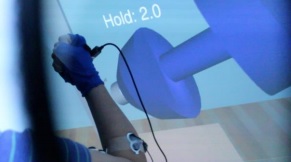Virtual Exertions
Physical Interactions in a Virtual Reality CAVE for Simulating Forceful Tasks
Robert G. Radwin
Karen B. Chen
Kevin Ponto
Ross D. Tredinnick

Abstract
This paper introduces the concept of virtual exertions, which utilizes real-time feedback from electromyograms (EMG), combined with tracked body movements, to simulate forceful exertions (e.g. lifting, pushing, and pulling) against projections of virtual reality objects. The user acts as if there is a real object and moves and contracts the same muscles normally used for the desired activities to suggest exerting forces against virtual objects actually viewed in their own hands as they are grasped and moved. In order to create virtual exertions, EMG muscle activity is monitored during rehearsed co-contractions of agonist/antagonist muscles used for specific exertions, and contraction patterns and levels are combined with tracked motion of the user’s body and hands for identifying when the participant is exerting sufficient force to displace the intended object. Continuous 3D visual feedback to the participant displays mechanical work against virtual objects with simulated inertial properties. A pilot study, where four participants performed both actual and virtual dumbbell lifting tasks, observed that ratings of perceived exertions (RPE), biceps EMG recruitment, and localized muscle fatigue (mean power frequency) were consistent with the actual task. Biceps and triceps EMG co-contractions were proportionally greater for the virtual case.